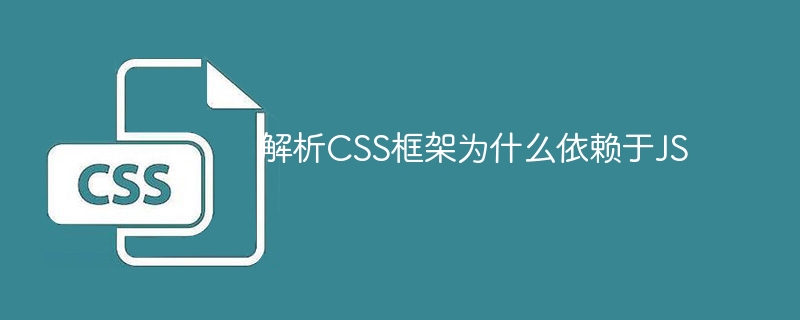

Analysis of why the CSS framework relies on JS, specific code examples are required
Learning and mastering the CSS framework is a basic requirement for every front-end developer, and the CSS framework can help with development People quickly build beautiful, responsive web page layouts and styles. However, some CSS frameworks often rely on JavaScript (JS) in order to achieve more functions. This article will analyze this issue and provide specific code examples to illustrate why CSS frameworks require JS support.
CSS frameworks typically contain a set of styling and layout rules that are automatically applied across web pages and achieve consistent appearance and behavior. However, CSS itself cannot achieve complex interactions and dynamic effects, which is one of the reasons why CSS frameworks require JS.
First of all, the CSS framework requires JS to implement responsive layout. Responsive layout adjusts the layout and style of the page according to the different sizes and resolutions of the device. In CSS we can use media queries to define different styles on different devices, but this only works on a fixed screen width. JS can monitor changes in window size and modify CSS properties in real time to adapt to different screen widths.
The following is a simple example that demonstrates how to use JS to listen to window size changes and modify CSS styles:
<!DOCTYPE html>
<html>
<head>
<style>
.box {
width: 200px;
height: 200px;
background-color: red;
}
@media (max-width: 600px) {
.box {
background-color: blue;
}
}
</style>
</head>
<body>
<div class="box"></div>
<script>
window.addEventListener('resize', function() {
var box = document.querySelector('.box');
if (window.innerWidth < 600) {
box.style.backgroundColor = 'blue';
} else {
box.style.backgroundColor = 'red';
}
});
</script>
</body>
</html>In this example, when the window width is less than 600 pixels, The CSS style will turn blue. When the window width is greater than 600 pixels, the CSS style will turn red. This responsive layout is implemented through JS, and the CSS framework requires the support of JS to achieve similar functions.
Secondly, the CSS framework requires JS to achieve complex dynamic effects. Although CSS can achieve some transition effects and animations, its functions are relatively limited. JS has a rich animation and effect library, such as jQuery and GreenSock, which can achieve complex dynamic effects by manipulating the properties of DOM elements.
The following is a simple example that demonstrates how to use JS and CSS to achieve a fade effect:
<!DOCTYPE html>
<html>
<head>
<style>
.box {
width: 200px;
height: 200px;
background-color: red;
opacity: 0;
transition: opacity 0.5s;
}
.box.fade-in {
opacity: 1;
}
</style>
</head>
<body>
<div class="box"></div>
<script>
window.addEventListener('load', function() {
var box = document.querySelector('.box');
box.classList.add('fade-in');
});
</script>
</body>
</html>In this example, when the page is loaded, JS will dynamically Add a .fade-in class name to the .box element to trigger the transition effect in CSS. In this way, we can use JS to achieve more complex and detailed dynamic effects.
To sum up, although the CSS framework is very powerful in realizing web page layout and style, in order to achieve more functions and effects, it often requires the support of JS. JS can be used to implement responsive layout and complex dynamic effects, making the CSS framework more flexible and powerful during the development process.
Of course, these are just some examples of CSS frameworks that depend on JS, and the specific situations may vary between different frameworks. When using the CSS framework, developers should have a deep understanding of the characteristics and requirements of the framework itself, and use JS rationally to assist in achieving the required functions and effects.
The above is the detailed content of Why CSS frameworks need to rely on JS parsing. For more information, please follow other related articles on the PHP Chinese website!




